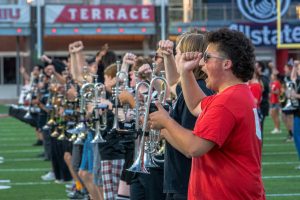Dancin’ with the Time
April 24, 2003
If your lifelong goal is to watch a dance performance about medieval violence and monks who drink too much, then the NIU School of Theatre and Dance will meet your expectations.
“Carmina Burana” will be performed at 7:30 p.m. on April 24 to 26 and at 2 p.m. on April 27 at the Stevens Building’s O’Connell Theatre.
Paula Frasz, an associate professor in the NIU School of Theatre and Dance, is the choreographer of the dance.
Frasz said the story is a collection of about 25 shorter stories about monks living fervishly in the Middle Ages. They go around drinking, enjoying women and life.
“[‘Carmina Buraana’] is usually done with music and singers, but I decided to do it with music and dance,” Frasz said.
Because there only are only so many ways to portray drinking and sex through dance, Frasz had to use some of her own interpretation to complete the performance successfully.
“I’ve filled in the gaps with war, love and glimpses of medieval life,” Frasz said. “Some are matches with the text and some are just from my imagination.
“It’s got sex, violence, humor, beautiful bodies in gorgeous costumes with a huge set and glorious music,” she added.
Frasz also said that “Carmina Burana” is the first time NIU will hold a full-length modern dance performance.
Aaron Fowles, a senior theater major and stage manager of the show, said the set will be interesting as well.
The stage will be set for the start of the performance as a castle that is made up of 22 pieces. Throughout the show, the castle will be slowly torn away.
“While they’re dancing, they will grab a piece every once in a while until there will be nothing left,” Fowles said.
J.P. Tenuta, a senior dance major and the male lead, said the dance makes a lot of commentary on the class system of the Middle Ages, along with religion and roles of society.
“People are split up by nobility and common people. Each group is dressed different with different movement styles,” Tenuta said, referring to the costumes and the different classes they represent.
Tenuta also explained that the destruction of the castle adds meaning to the dance.
“[It’s] the breaking down of the superstition of classes and by the end making anything possible.”






